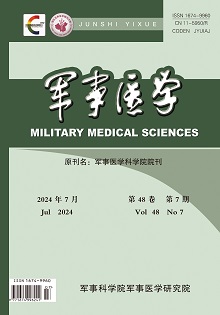Original articles
LIU Yichen, YAN Dongfei, LI Zhixin, MAO Yingchun, LI Zhihui, DONG Guofu, WANG Changzhen
Objective To investigate the role of Kelch-like- epichlorohydrin-associated protein1/nuclear factor erythroid-derived factor-2-related factor 2 (Keap1-Nrf2) and nuclear factor-κB(NF-κB) signaling pathways in sepsis-associated encephalopathy(SAE). Methods Male C57BL/6J mice of SPF were randomly divided into four groups (n=10): the control group and LPS 6 h, 24 h and 48 h groups. The behavioral changes of the mice were assessed based on their general conditions and open field test(OFT). ELISA was used to measure the levels of pro-inflammatory cytokines in mouse serum, and the antioxidant capacity assay kit to examine antioxidant activity in brain tissues of mice. Real-time quantitative PCR(qPCR) was adopted to detect the mRNA levels of toll-like receptor4 (Tlr4), NF-κB, Keap1 and Nrf2 in the hippocampus, and to determine protein expressions of NF-κB、Nrf2、Keap1 and Tlr4 with Western blotting. Results Compared to the control group, the serum concentrations of interleukin 6 (IL-6) in lipopolysaccharide(LPS) groups increased at 6 h, and reached the peak at 24 h and 48 h (P<0.01). The levels of serum interleukin 18 (IL-18) in the LPS groups increased significantly at 6 h and 24 h (P<0.01) but there was no statistically significant difference compared with the 48h group. The results indicated the activity of superoxide dismutase(SOD) and glutathione(GSH) in brain tissues in LPS groups increased(P<0.01). OFT results showed the time spent in the center of the open field, the distance covered around the center, and total distance covered by mice in LPS groups were significantly reduced (P<0.01),except for the time spent in the center of the open field in the LPS 24 h group. The mRNA expressions of Tlr4 and (LPS 6 h, 48 h) NF-κB in the hippocampus tissue of mice in LPS groups were elevated (P<0.05), so were the mRNA expressions of Keap1 and Nrf2 in LPS 6 h group. Additionally, the protein expressions of NF-κB, Keap1 and Tlr4 increased in LPS groups, so did the protein expression of Nrf2 in LPS 24 h and 48 h groups(P<0.05). Conclusion Keap1-Nrf2 and NF-κB signaling pathways may play a certain role in SAE.;
